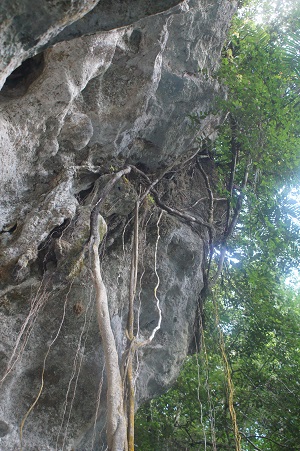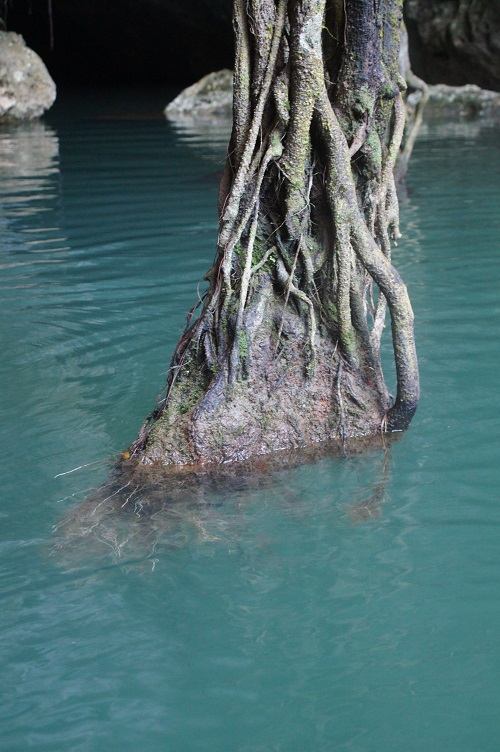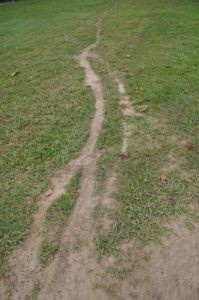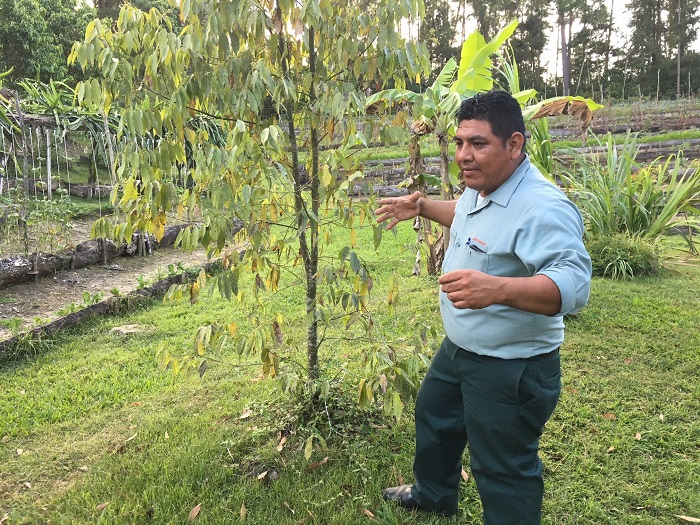
Elicer Tribz explains how to make cinnamon spice from the bark of the cinnamon tree.
On the hillside above the Blancaneaux Lodge in Belize, six gardeners tend to a three-and-a-half-acre organic garden that supplies the hotel’s three restaurants with delectable vegetables, fruits, beans, and herbs.
As a prelude to a communal dinner at the hotel’s Garden restaurant, Elicer Tribz takes lodge guests on a tour of the garden. He proudly describes how he and his fellow gardeners nurture the soil and tend to the lettuces (10 varieties), the cherry and Roma tomatoes, the squash, zucchini, carrots and celery, and innumerable herb bushes and fruit trees. He explains how the gardeners create a natural fungicide using microorganisms found in the rain forest, and how they man the garden literally around the clock when fending off attacks of woolly caterpillars.
Throughout the tour, Tribz pinches off leaves for the guests to smell and taste. The vegetables are not only free of pesticides and herbicides, thus safe to eat off the vine without washing, they are very flavorful. The fresh food at Blancaneaux puts to shame the grocery store vegetables that I normally eat, genetically engineered as they are to survive lengthy spells as agricultural inventory. At Blancaneaux guests enter a world of more intense taste.
I can also vouch that after three days of hiking like a mountain goat and eating healthy meals, I felt great. This was life in the blue zone — the recipe for living a longer, healthier life.
Eating organic food was not an experience my wife and I had been looking for when planning our vacation. It was an unexpected bonus. As total coincidence would have it, on the airline flight to Belize I plowed through “The Dental Diet,” which touted the virtues of organic and free-range foods. Combining the theory from that book with the experience of eating organic food at Blancaneaux set into motion a train of thought about the relationship between health, the “ancestral diet” (as author Steven Lin calls it), economic disruption, food deserts, and economic inequality.
Let me advance three nested propositions. First, many of the chronic diseases in 21st century society — not just the biggies like heart disease, obesity and diabetes but a host of auto-immune diseases — originate from our modern diet. To prevent those diseases rather than merely treat them, North Americans, Europeans, and anyone else embracing a conventional “western” diet” must radically change their eating patterns — most notably by consuming fewer processed sugars and carbohydrates, more grass-fed cattle and poultry, and more fresh fruits, beans and vegetables. Second, a dietary revolution by necessity will require a wrenching agricultural and food-processing revolution. And third, the transition from industrial agriculture to free range/organics will accentuate the divide between those who can afford good food and the health benefits that accrue from it and those who can’t.
Lin looks at health and diet issues through the prism of his discipline: dentistry and oral health. Our mouths host an extensive biome that interacts with our bloodstream (especially if we have gum disease) and our gut biome (every time we swallow saliva). Lin’s exploration of this interaction, which medical science is only beginning to understand, led him to several intriguing perspectives and insights.
Lin argues that dental disease was almost non-existent among early homo sapiens. Likewise, crooked teeth, which we moderns think of as the unlucky outcome of the genetic lottery, were equally rare. The absence of dental maladies among pre-agricultural humans is all the more remarkable when one considers that they did not avail themselves of tooth brushes, tooth paste, dental picks, braces, and orthodontics! How could that be possible? Lin’s answer: The ancestral diet of meat, grains, fruit, and, later, dairy — not processed carbohydrates — allowed the mouth biome to remain in balance, reducing acidity, and for the upper and lower jaws to grow larger and stronger with room to accommodate more teeth. With plenty of space in the jaw, teeth in early homo sapiens, like those of pre-agricultural societies documented within living memory, grew in straight and even.
Cavities, bleeding gums and crooked teeth are only the most visible of the health disorders set into motion by the agricultural revolution, with its widespread adoption of carbohydrate-laden wheat, rice, and maize, and then the industrial revolution, with its widespread adoption of processed sugars. The positive accomplishment of the agricultural and industrial revolutions is that they fed billions of people. The downside is that industrially produced food afflicts mankind with a host of chronic diseases.
Animal products, says Lin, should be sourced from pasture-raised and free-range livestock, not from grain-fed livestock pumped up with antibiotics. Likewise, seafood should be caught from natural waters, not farmed. Fruits and vegetables should not be sprayed with pesticides and antibiotics, which alter the microbiome of the soil as well as that of their own genes. We should purge sugar, white flour, vegetable oils from our diets. In their place we should consume more fiber, probiotics and prebiotics. Throw your Captain Crunch into the trashcan, and eat your Brussel sprouts.
To my mind, the virtue of Lin’s book is not the nutritional guidelines — they will be familiar to many readers following other dietary regimens — as much as the persuasive, science-based justification he offers for them. For purposes of argument, let us accept that widespread adoption of a organic/free-range diet is necessary to restore the health of America’s population with its many chronic medical conditions. Now let us confront the implications of adopting those guidelines on a massive scale.
We know that vegetables, beans and fruits can be raised free of herbicides, pesticides and antiobiotics on a fairly large scale. Blancaneaux shows how it can be done, as do innumerable other organic farms such as Polyface Farm in Virginia’s Shenandoah Valley. The question is at what cost. Organic produce is more expensive, mainly because the gardening is more labor intensive. Grass-fed beef and free-range chicken also are more expensive, mainly because they require more land.
Organic and free-range foods are niche products, accounting for 4% of total U.S. food sales, and they have little impact on agricultural land and labor markets. But increase organics’ market share to 50% — never mind 100% — and farms will experience massive labor shortages and land scarcity. As these key inputs of organic food increase in cost, the price of organic food will rise as well. While organic and free-range food command, say, a 30% price premium in grocery stores today — I base that guesstimate on the price differential I see at Kroger — I conjecture that the premium could well triple or quadruple.
America’s educational divide will accentuate the differential impact on different segments of the population. Those most motivated to alter their diets — not any easy task — are those with the education, income and inclination to read books like “The Dental Diet” and the agency to believe that they have the power to change their lives for the better. Lower-income Americans, who tend to be more fatalistic about their lot in life, will be less likely to change.
If America has a problem now with food deserts — unequal access to healthy food — the disparity will increase dramatically if the price of organic/free-range food doubles. The nutritional divide will become more marked, and so will the ensuing health divide.
How do we offset such a pessimistic outcome? The default response would be to give poor people more fresh food. But giving them healthier food provides no guarantee that they will eat it. Far better would it be to involve the poor in raising their own food, whether cooperatively in communal urban farms, individually in back-yard gardens, or perhaps as employees in multi-storied urban greenhouses. People place far greater value in a thing that they earn through their own sweat and toil.
Whatever the long-term solution to the problem of food inequality, the scientific case is growing for the argument that we are what we eat. I’m ready to do what it takes to stay healthy and active, even if it means eating more cauliflower and fewer french fries. Hopefully, other Americans will find a way to do so, too.
 By Mark Greene
By Mark Greene
 This will be one of those blog posts where many readers will ignore the substance of my arguments and go straight for the jugular — Dominion Energy Virginia sponsors this blog, I’m a shill for Dominion, and, therefore, anything and everything I say can be discounted without further thought. If you’re one of those people, I know I won’t persuade you. But please, if you object to my conclusion, don’t settle for the cheap ad hominem shot. Explain to me why I’m wrong.
This will be one of those blog posts where many readers will ignore the substance of my arguments and go straight for the jugular — Dominion Energy Virginia sponsors this blog, I’m a shill for Dominion, and, therefore, anything and everything I say can be discounted without further thought. If you’re one of those people, I know I won’t persuade you. But please, if you object to my conclusion, don’t settle for the cheap ad hominem shot. Explain to me why I’m wrong.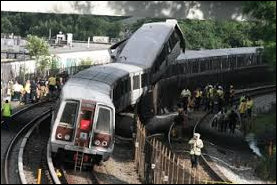 Uh, oh, the Metro funding deal isn’t sealed yet. The Washington, D.C., city council could be the spoiler. While Mayor Muriel E. Bowser has asked council to back a $178.5 million annual increase in funding for the commuter rail system to go along with $154 million from Virginia and $150 from Maryland, a council faction by Chairman Phil Mendelson is balking.
Uh, oh, the Metro funding deal isn’t sealed yet. The Washington, D.C., city council could be the spoiler. While Mayor Muriel E. Bowser has asked council to back a $178.5 million annual increase in funding for the commuter rail system to go along with $154 million from Virginia and $150 from Maryland, a council faction by Chairman Phil Mendelson is balking.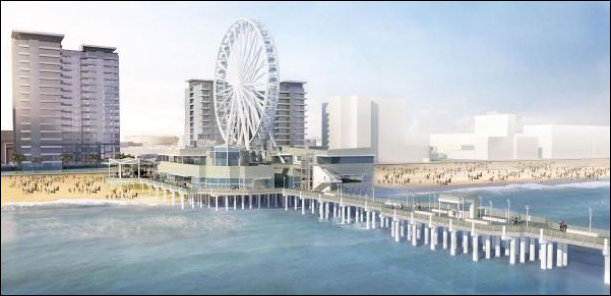

 The public relations battle over the Atlantic Coast Pipeline continues unabated even as managing partner Dominion Energy edges closer to beginning construction of the 600-mile project. The latest flap surfaced in the
The public relations battle over the Atlantic Coast Pipeline continues unabated even as managing partner Dominion Energy edges closer to beginning construction of the 600-mile project. The latest flap surfaced in the 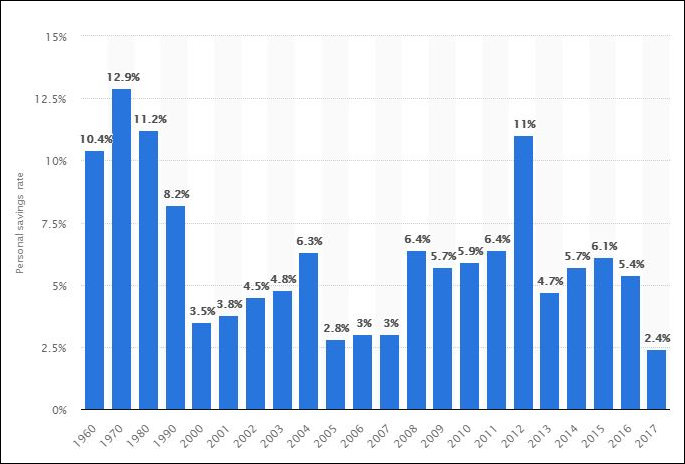
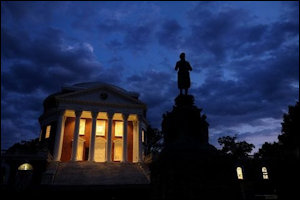

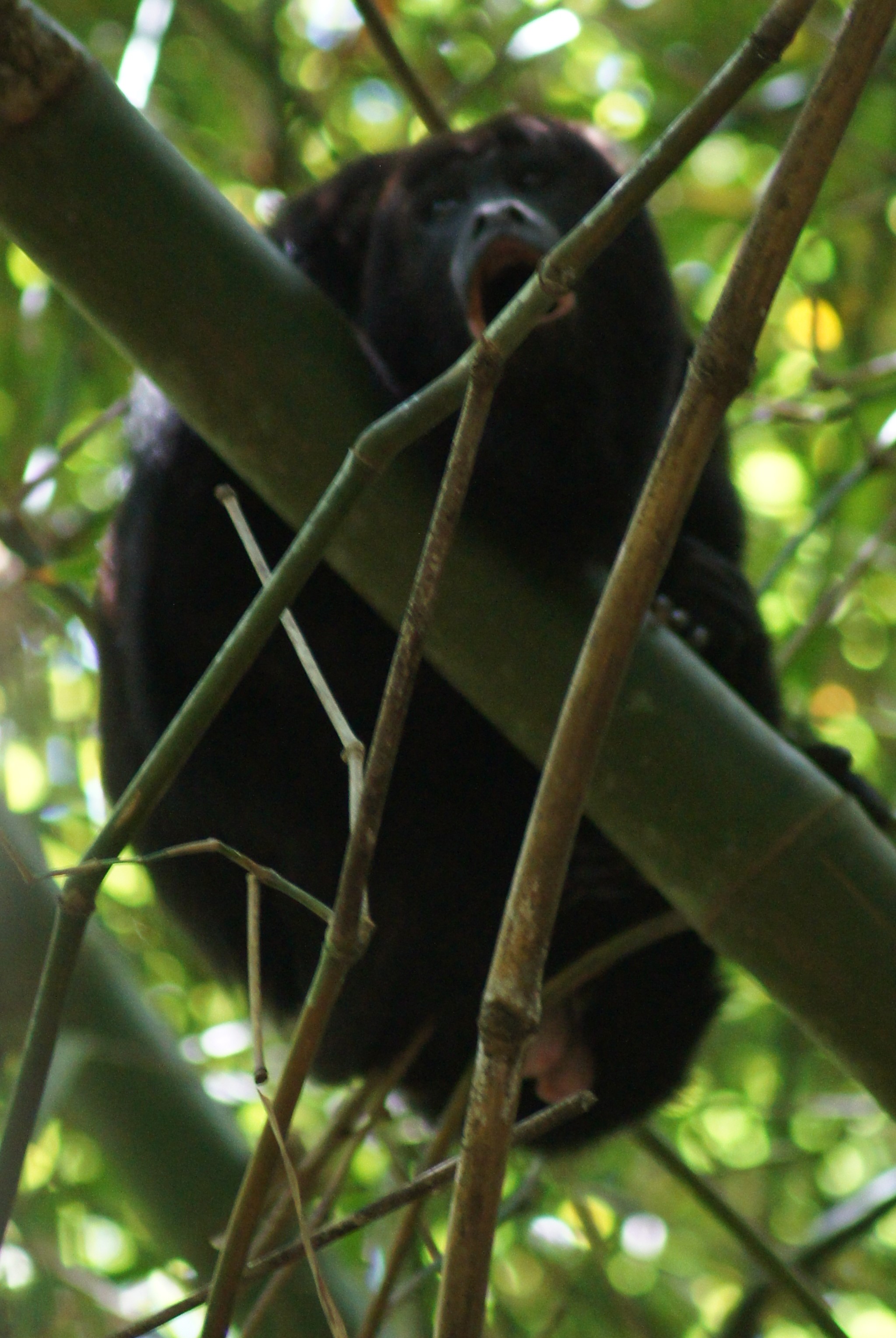 Finally – a howler monkey spotting!
Finally – a howler monkey spotting! by Jack Hubbard
by Jack Hubbard